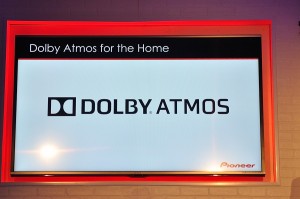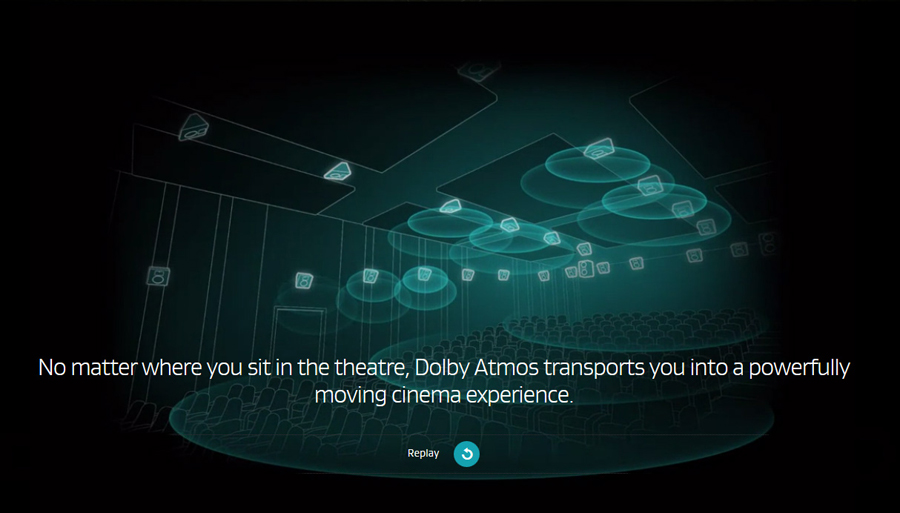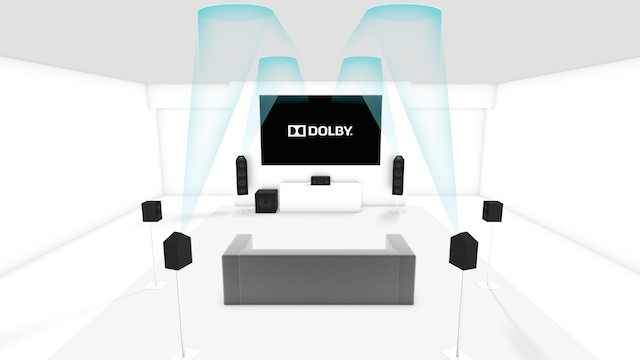GUEST POST
 Is Dolby’s new Atmos format the next frontier in surround sound processing? Or will it merit a repeat of Paul Klipsch’s famous line: “Ho, hum, another breakthrough”?
Is Dolby’s new Atmos format the next frontier in surround sound processing? Or will it merit a repeat of Paul Klipsch’s famous line: “Ho, hum, another breakthrough”?
You’d certainly think the former after prowling the aisles at the just-concluded CE Week in NYC. Both Onkyo and Pioneer showed prototype Atmos-enabled A/V receivers (complete with demonstrations under what must be called “challenging” conditions) while Yamaha, Denon, Marantz, and Integra all indicate they’ll be ready with an array of products in late Q3 or early Q4 this year. But will Paul Klipsch be proven prophetic once again, even if posthumously? That remains to be seen.
The Thinking Behind Atmos…
Let’s begin our exploration with a brief and thoroughly incomplete description of what Atmos is, what it attempts to do, and how a home theater enthusiast might benefit.
At the outset, know that Dolby is not making a description of Atmos easy. There’s a real dearth of available technical information (emphasis on “available”) to the extent that we wondered if some of Dolby’s manufacturing partners jumped the gun with product announcements to take advantage of the publicity they’d get at CE Week. As we’ll see shortly, the consumer version of Atmos really isn’t ready for prime time anyway.
That being said, Atmos is the result of Dolby’s ongoing research into generating an even more convincing surround soundfield than was previously possible. Atmos recognizes the limitations of using comparatively few individual speakers (think 5.1and it’s more complex descendants), to envelop the listener. each fed a channel-specific stream of audio information.
A break with past paradigms…
As such, Atmos is a break from the decades-old paradigm that began with Dolby Stereo in 1975 and Dolby Surround, its consumerized cousin, in 1982. This traditional approach was – and still is – based on each speaker in a conventional home theater array receiving channel-specific information contained in the source itself. Each channel was “locked in,” as it were. Yes, channels were dynamic in that the information was changing constantly. But each channel was static in that left front information from that source always ended up at the left front speaker, right surround information went to the right surround speaker. And that’s how it always was.
Until Atmos.
Atmos’ developers first rethought the basic concept of a surround soundfield. Their emerging model was that the sonic environment we all function in – and the environment a film’s creators want us to inhabit – might be easier to recreate if we think of various components of this environment as “sound objects” that can be manipulated at will, to migrate as it were from point to point in the sonic hemisphere rather than being locked in as a channel-based signal that’s routed through specific speakers to make up the whole.
Although an Atmos soundtrack begins with what Dolby calls a “base layer” that’s surprisingly conventional, a second layer containing these moveable sonic components is embedded onto the base layer. It’s these elements that Atmos positions initially and then moves to conform to the filmmaker’s creative vision. .
What’s the “Meta” with Your Data?…
But what governs this placement and movement? Metadata – or “data about the data” – that’s what!
Metadata can be a difficult concept to grasp. But it’s easy if you think of an image taken by your digital camera. Sure, the image is there. (It’s data or, if you want to be really picky, “data essence.”) But there’s other information there too: an image sequence number, color depth information, resolution, the date you captured that image, the camera you used, even the camera’s settings (f-stop, shutter speed, etc.) That’s the “metadata.” And it’s all a part of every image you take!
It’s roughly the same with audio information in the digital world. .
There’s the data (the signal’s frequency, loudness, etc.). And there’s the metadata (where a particular data stream should appear, is any dynamic range adjustment possible, and other factors.)
These metadata parameters are added to the data during the mixing process. They’re dynamic in another way, too – they act as “hooks,” as it were, that allow the programming built into downstream processors to move the data, change the apparent origin of the “sound objects” to conform to different speaker configurations, etc.
In short, metadata provides the programming built into virtually every processor the information it needs to best align the data with a desired result.
Back To The Idea Board
Once this conceptual shift – from channel-based to object-based processing – occurred, the next step was to figure out how to create and place these objects more accurately and move them more believably (in a virtual sense, of course) in a room regardless of a specific system’s capabilities.
In this quest, Dolby developed complex psychoacoustically-validated mathematic equations or algorithms that led to more effective manipulation of a soundfield’s component parts. These algorithms keyed on the metadata “tags” added to the audio information with the intention of producing a more believable aural environment then was previously possible. .
As you’ve no doubt surmised, this process happens “on the fly” and scales itself dynamically to change the elements of that soundfield to best match the capabilities of a particular home theater system regardless of that system’s physical configuration. The old model, that of a sonic traffic cop simply routing specific sounds to specific speakers, no longer applies.
The hoped-for result? A coherent aural hemisphere in much greater conformity with the creative intent.
Enter Height . . .

. . . And Its Perils
The illusion of height, something Atmos apostles are preaching as a major advantage, isn’t new. Both Dolby and its nemesis, DTS, have been promoting the advantages of speaker placement close to the ceiling at the front or the sides of the listening/viewing area for some time.
But “close to” the ceiling is not “in” the ceiling. Nor is “aimed at” the ceiling. And this is where things get a bit complicated.
Atmos, at least in its professional incarnation, can support up to 10 in-ceiling speakers in addition to 24 (yes, count ‘em – 24) speakers on the floor.
Knowing that such an installation is simply impossible for normal homes, and most likely recognizing the practical limits of the new technology, Dolby seems to have focused on four in-ceiling transducers as a more workable number. But even here, aesthetic, financial, and acoustic considerations intrude. Who wants to augment an existing system by cutting four holes in the ceiling of a home’s major entertainment area and mounting suitable speakers there? Does the consumer call a custom installer? Some will, of course, but our best guess is that most won’t.
There are other solutions.
Atmos-enabling the consumer’s home…
Pioneer (and soon, others) has announced “Atmos-enabled” speakers. These have two sets of binding posts, one leading to the normal front-facing drivers, the second to a driver or drivers on the angled top of the enclosure to project sound upwards to reflect off the ceiling, thus creating a sense of height.
Unfortunately, this solution would force consumers to relegate their existing speakers to the “no longer ready for prime time” equipment pile every home theater enthusiast eventually amasses. In short, for most of us, this is no solution at all.
Definitive Technology is promoting new “Elevation” modules. These small enclosures augment the original home theater speaker array and are, like the Pioneer offerings, aimed at the ceiling. Although this solution does not necessarily obsolete an in-place speaker array, there’s still the challenge of integrating these additional modules in rooms with carefully executed décor.
Seeing the ceiling…
The point of both strategies is to use the ceiling’s acoustic reflectivity to bounce signals back into the listening/viewing area to create the illusion of height. But that reflectivity, and thus the amount of height information bounced back, is dependent on the composition, the shape, and the height of that ceiling.
Have an acoustically damped or naturally absorbent ceiling to cut down ambient noise? Don’t count on speakers aimed in that direction to do much. (So we’re back to our first option of installing height speakers in the ceiling, aren’t we?) Have a very high, a vaulted, or cathedral-style ceiling? Same problem.
Even if your ceiling is plain old flat sheetrock, it can pose a challenge if it’s much higher than 12 feet tall. (Dolby claims a ceiling height of 14 feet is “acceptable.” We’d like to see a working definition of that term before voicing an opinion. As things stand now, we remain cautious.)
So the height information will not be consistent from installation to installation. (This may be a moot point in that a conventionally-configured 5.1 or 7.1 system can – and often does – produce a soundfield with, what some would call “unusual” characteristics.
The Firmware Issue…
Although the microprocessors needed for Atmos are available now, the firmware – the “burned in” program that tells the processor what to do – is not. That’s still being worked on and thus any demonstrations you might hear now are only approximations (maybe close, maybe not) of what will be available in Q3 or Q4 of this year when Dolby releases those instructions sets to manufacturers of A/V receivers or “pre/pros.”
Thus, the claims of Atmos’ sonic superiority simply can’t be verified now. How much does the vaunted height information add to enjoying a soundtrack? How important will “sound objects” be in creating a more realistic soundfield? How “seamless” will this soundfield be?
We can’t know. At least not now.
The Demo Question…
Dolby presented and demonstrated Atmos (at least on the East Coast) some time ago at a meeting for the New York chapter of the Audio Engineering Society. This event took place at the Dolby Theater, a well-outfitted and rather large screening room on the ground floor of Dolby’s offices on Sixth Avenue. The explanations were long, complex, and largely theoretical. (That’s not necessarily a bad thing but large parts of the evening were way over the heads of some of the attendees.) The demonstration made full use of the rather extensive speaker array in place at the time. However, acoustic memory being what it is, we simply won’t judge what we think we remember hearing.
Show conditions being what they are, more recent demonstrations at CE Week (June 24-26, 2014) were, unfortunately, inconclusive. Specifically, we were unable to accurately verify the contribution height information added to the soundtrack, nor could we determine overall coherence. A more painstaking evaluation must wait. In fact, until the firmware is in its final iteration, we really can’t say much at all other than to opine that these CE Week demos weren’t bad.
Where Do We Go From Here?…
First, we need to define Atmos’s benefits for the consumer!
Some front-of-the-pack or cost-no-object aficionados will always scramble to be the first on their block to adopt new technologies. (Thank God for them – they helped build our industry!) But will the illusion of height be enough to attract the average home theater enthusiast, particularly given the challenge and expense of more equipment? If not, what are Atmos’s other advantages? Is a more coherent soundstage appealing? Given the subtlety of that difference, it may be next to impossible to effectively demonstrate that in a conventional selling environment.
True, we certainly can’t ignore the potential appeal of Atmos-enabled soundtracks on Blu-ray discs. But discs, according to many, are already losing ground to the onslaught of streaming and download technologies. Undoubtedly, Atmos will be there also but the benefit questions remain.
The toughest question…
We certainly understand the Atmos appeal to manufacturers. It is an opportunity to sell something new through already-established distribution channels. That is, after all, the reason many companies have announced the imminent arrival (once the firmware is finalized of course) of Atmos-capable A/V receivers and the new speakers we’ve previously identified. But even here, we’re hearing caution in that some companies have chosen to remain on the sidelines to see how fast the Atmos bandwagon storms into the marketplace.
Basically, we have to answer this: What position will Atmos carve out for itself in the marketplace? Will it become the “next big thing” all home theater customers aspire to? Or will it, like 3D TV, fall victim to the toughest question of all – “Why?”
GUEST POST – LEN SCHNEIDER
 This post was written by our good friend and knowledgeable technologist, Len Schneider, President of TechniCom Corp.
This post was written by our good friend and knowledgeable technologist, Len Schneider, President of TechniCom Corp.
Originally a retail sales professional and then a manufacturer’s representative, Len Schneider moved to product development and marketing positions at Onkyo and Marantz among other companies. Sony’s former National Training Manager, he founded TechniCom Corporation as an independent consultant and added his development expertise to several award-winning audio/video components. A Life Member of the Audio Engineering Society, Len has written four books on home entertainment technology.
To learn more about Len and TechniCom Corp., SEE: www.technicomcorp.com.




Leave a Reply